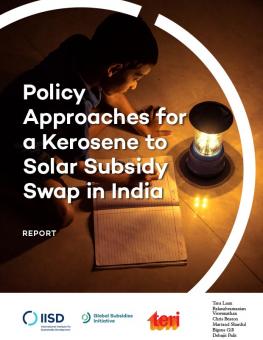
Policy Approaches for a Kerosene to Solar Subsidy Swap in India
India could save money and reduce indoor air pollution by switching kerosene subsidies to solar.
India could save money and reduce indoor air pollution by switching kerosene subsidies to solar.
Key Messages
- Switching subsides from kerosene to off-grid solar would benefit the millions of Indian households that suffer frequent blackouts or that cannot afford grid electricity.
- A range of off-grid solar products is now cheaper than kerosene over the lifespan of the technology. Surveys also indicate that people strongly prefer off-grid solar compared to kerosene, even if this means a reduction in the kerosene subsidy.
- This report shares a plan for India to swap kerosene subsidies for solar subsidies through a six-step implementation plan with the end goal of an India where there is clean and reliable power for all.
Kerosene is not an ideal fuel: it has negative health impacts, gives poor lighting, emits greenhouse gases, raises the fire risk and causes subsidy costs to soar when international oil prices rise.
Millions of households in India, however, continue to use kerosene lamps. They may not be able to afford electricity or the electricity grid has not reached their community. Electricity blackouts also drive some households to ignite their lamps.
This independent study by the International Institute for Sustainable Development (IISD) and The Energy and Resources Institute (TERI) shows that switching subsidies from kerosene to off-grid solar products would improve electricity access for households that still rely on kerosene. The costs of solar products have fallen in recent years; by spreading the initial costs over a solar product's lifetime, there are clear cost savings for households and taxpayers that justify the switch to solar.
This report provides a six-step implementation plan for governments. The first three steps provide options on funding, targeting recipients and selecting solar products. The next steps are presented as three separate pathways depending on whether the government chooses to subsidize consumers, manufacturers or financial products. The goal for each pathway is the same: to assist India’s transition to clean and reliable power for all.
You might also be interested in
State of the Sector: Critical energy transition minerals for India
This report presents a comprehensive strategy for securing a reliable supply of critical energy transition materials (CETMs) essential to India's clean energy and low-carbon technology initiatives.
Increased Support Needed to Achieve India's Clean Energy Goals
India is on track to achieve many of its 2030 clean energy goals but needs to step up government support measures to accelerate the deployment of offshore wind, electric vehicles, and green hydrogen, according to a new report.
India Faces Clean Energy Challenges as Energy Demand Soars and Global Fossil Fuel Subsidies Rise
New research finds the global energy crisis and increasing energy demand have pushed India's energy subsidies to a 9-year high.
G20 energy ministers call for cooperation on nuclear energy & low-emission hydrogen
The Group of 20 energy ministers' meeting concluded in Goa on July 22, 2023, with the final summary failing to include language on the phase-down of unabated fossil fuels.